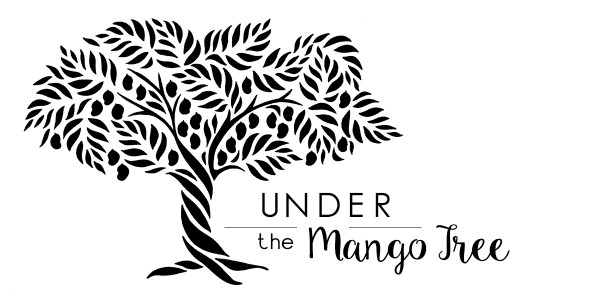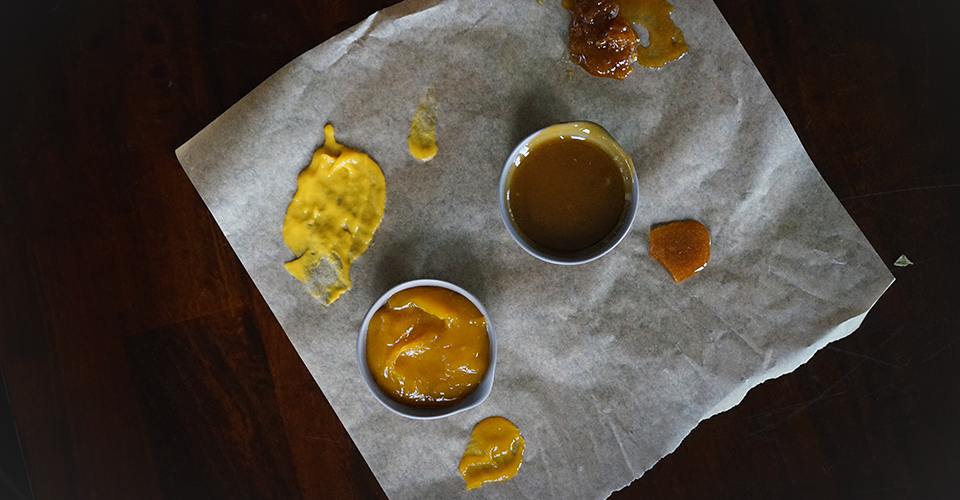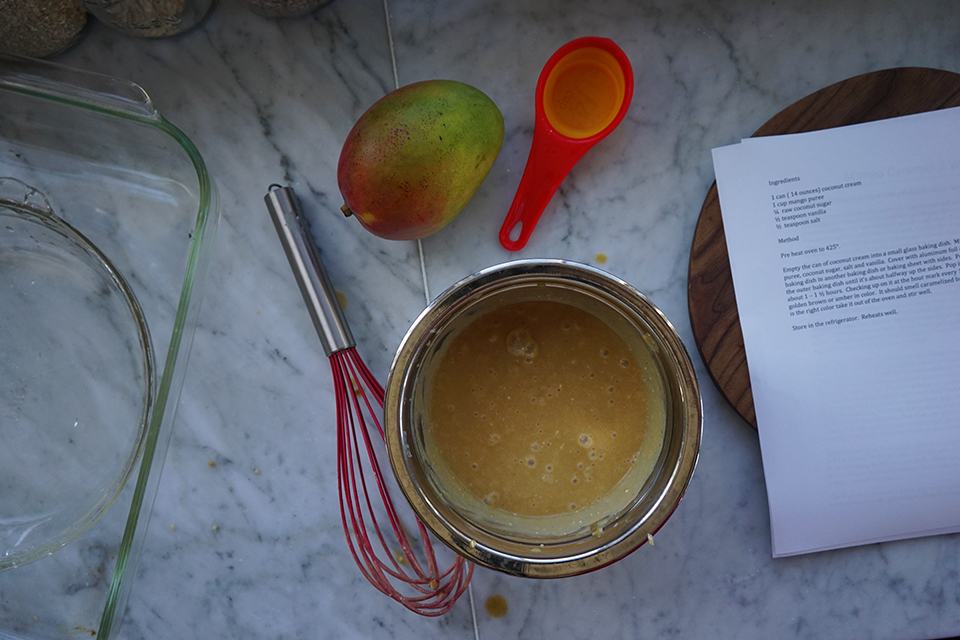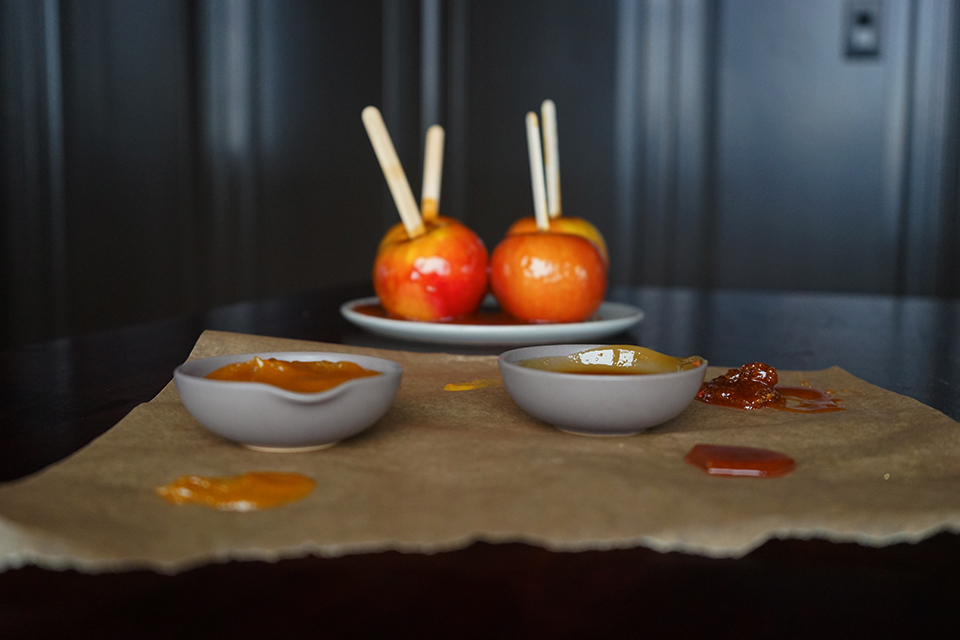Foolproof Caramel Recipes Using Mangoes: Salted (Classic), Faux and Tropical Vegan
There is no one way to make caramel. The variances of technique, ingredients and measurements are ample. It’s really a matter of taste and personal preference that guide choices. And when it comes to caramel there is one overlying rule: practice makes perfect.
Caramel is essentially the heating of sugar so that the molecules breakdown and reform, both in shape and color, and hence, flavor. From there is where most variations occur. Assorted sugars, butter quantities, and light or heavy cream (which some say is the thing that elevates it) are a few examples of these variations. Fruit juices, flavorings and spices can be added, and thickness is usually controlled through both the cooking time as well as ratio of ingredients. It’s almost dizzying trying to decide.
So how do mangoes fit in?
Mangoes are always on my brain, and with fall and Halloween on the horizon, caramel recipes abound my social media feed. It got me thinking about caramel and mangoes… Since mangoes have significant natural sugar, why wouldn’t they – in a purée form – caramelize as well when cooked to high enough heat?
I knew the mango flavor would be a great addition to classic caramel; there are tons of mango caramel recipes out there, but I figured there had to be some “science” to the caramelization of mangoes. Since my idea was to make caramel with less sugar and additives by using mangoes (and I often assert they are perfect for this kind of thing), there was nothing left to do besides test this science.
And so with a bucket of Ecuadorian organic Ataulfo mangoes, just perfectly ripe, I ventured into testing my theories on the caramelization of the sugars in mangoes. My results were better than expected and just in time for Halloween. Not only did the mango add natural sweetness, eliminating sugar in my classic caramel recipe, but it also contributed a golden tropical spicy note that lifted the flavor, adding brightness to the depth of the caramelized sugar. This brightness is reflected in all three recipes. I think it’s worth noting that adding fruit purées and juices to caramel is not abnormal, but most often they are added in the end, during the “butter phase”. Adding the high natural sugar fruit during the initial cooking phase adds a caramelized brightness. It’s warmer, deeper, and almost perfumes the caramel.
In my “(Faux) Mango Caramel” I was able to eliminate all sugar and just use a little smidgen of honey to increase caramelization. It turned out incredibly rich, layered with deep caramelized tropical fruit tones and the perfect thick caramel consistency. The “Vegan Mango Dulce De Leche”, eliminated all animal products and had the perfect caramel texture of the condensed milk version of this sweet spread. It reminded me of flavors I often encounter in Central America and Mexico. This is indeed my favorite of all three recipes.
Peak, flavorful fruit is essential to all of these recipes. Not all crops of fruit are super sweet or “high in brix”, as we say in the industry, so make sure to choose only sweet, great-tasting fruit if you are going to add it to caramel.
All of these recipes are a great way to use up any totally-ripe mangoes you might have hanging around, especially in the fall and winter, where caramel seems more inviting than Mango Agua Fresca or a Mango Margarita, which are my other favorite choices for totally ripe mangoes. Maybe now, after reading this, totally ripe mangoes will give you a hint of inspiration and lead to mango caramel. Sometimes with caramel we need reminding on how easy it is to make, and that all the ingredients are usually on hand. Most importantly, remember that when it comes to caramel, practice makes perfect.
The recipes below all call for mango purée (thin version). The simplest way to make it is to blend fresh mangoes with a little but of liquid. Various recipes need thicker or thinner consistencies. In this case we need a thinner version than normal so I like this ratio: 1 ½ cups chopped mango and ½ cup water. And a few splashes of cognac or rum, it never hurt anyone!
Salted Mango Caramel (Classic Caramel)
There is nothing quite like the classic sugar caramelizing while mixing with butter and cream, which creates a deep and rich, luxurious sauce like no other. It’s also fairly easy to make. It requires some practice, but once you have it down, it’s pretty foolproof. The main problems to watch for are sugar crystals or sugar clumps forming, which come from stirring too much and burning it. It also burns really easily at a certain point or moment, and there is no coming back from the taste of burnt sugar. You can also undercook it, which results in a sweet syrupy taste, with zero depth. Practicing often will escort you to the Oprah “ah-ha!” moment of caramel making…that moment when you know it’s just right, and you can only get there from trial and error.
Homemade classic caramel is something that needs to be eaten soon after it’s made for optimal texture and flavor. I personally don’t store mine in the fridge because I think the texture changes once it’s been refrigerated, and I don’t believe it reheats well. I store it in a jar on the counter and use it up within 48 hours of making it, which isn’t hard to do. You can store in in the fridge if you want to hold onto it longer and it should keep for a few weeks.
Makes about 2 cups
Ingredients
½ cup heavy cream
1 teaspoon vanilla
1 pinch ground cardamom
1 pinch or 1 teaspoon kosher salt (if you like salted caramel use the 1 teaspoon measure)
¾ cup sugar
½ cup mango puree (thin version)
1 stick (8 tablespoons) butter, cubed and room temperature
Method
Mix together the cream, vanilla and cardamom and warm them in the microwave or on the stove, set side at room temperature.
Combine the sugar and mango purée in a medium, heavy bottom saucepan and stir until combined. Bring the mixture to a boil on medium-high heat without stirring. Once the mixture comes to a boil increase heat to high and continue to cook until the sauce begins to turn a deep caramel or amber color. In order to keep the mixture from burning you may need to swirl the pan a bit, but do not stir. Be careful not to burn the mixture and only swirl occasionally. Stirring causes the formation of sugar crystals or in laymen’s terms, tiny, hard sugar clumps. The entire process takes about 10 minutes, give or take. Once the caramel is amber in color remove the pan from the heat. Slowly and gently whisk in butter a little at a time until it’s all mixed in, smooth and shiny. Stir in the warmed cream mixture until incorporated fully.
Refrigerate if not using right away.
(Faux) Mango Caramel
This is what I call my “healthy kids” caramel. Mangoes’ natural sugars and sweetness make their own “faux” caramel when cooked down. It’s important to use super sweet, ripe mangoes that taste really good. It’s hard to mess this up, it requires about 8 minutes of constant attention but not much else. Your kids will love it and you will feel awesome about feeding it to them.
Makes about ¾ cup caramel
Ingredients
1 cup fresh mango purée (thin version)
½ teaspoon cinnamon
1 tablespoon honey
Method
Place all of the ingredients in a small, heavy-bottom saucepan on the stove and turn the burner on medium high. Allow the mixture to come to a boil and then gently stir for about 6-8 minutes until the mixture turns thick and caramel-colored. Make sure that you do not burn the mixture. Remove from heat and allow to cool. Serve warm or cold.
In my adult version I toss in a few tablespoons of cognac.
Vegan Mango Dulce De Leche (Tropical Vegan)
This oven-baked caramel, technically a Dulce de Leche (“milk jam” being the literal translation), is basically caramelized milk jam that combines the caramelized coconut milk with mango, creating an exotic tropical spread. Cooked in the oven with very little prep work and very tasty results.
Coconut cream instead of coconut milk keeps this extremely thick and rich.
Makes about 2 cups
Ingredients
1 can (14 ounces) coconut cream
1 cup mango purée (thin version)
¼ raw coconut sugar
½ teaspoon vanilla
½ teaspoon salt
Method
Pre heat oven to 425°.
Whisk together the coconut cream, mango purée, sugar, vanilla and salt until smooth. Pour the mixture into a small glass baking dish and cover with aluminum foil. Place the glass baking dish in another larger baking dish or baking sheet with high sides. Pour hot water into the outer baking dish until it’s about halfway up the sides. Pop it in the oven for about 1 – 1 ½ hours. Checking up on it at the hour mark every 10 minutes until it is golden brown, amber in color. It should smell caramelized (but not burnt) and be thick and pudding-like in consistency. Once it reaches your desired amber hue, take it out of the oven and stir until smooth.
Store in the refrigerator for up to 3 weeks. Reheats well.














No Comments